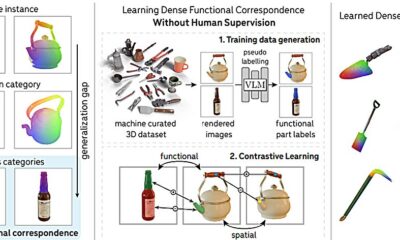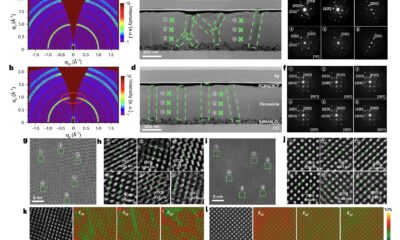Tech
Meta and TikTok to obey Australia under-16 social media ban

Tech giants Meta and TikTok said Tuesday they will obey Australia’s under-16 social media ban but warned the landmark laws could prove difficult to enforce.
Australia will from December 10 force social media platforms such as Facebook, Instagram and TikTok to remove users under the age of 16.
There is keen interest in whether Australia’s sweeping restrictions can work, as regulators around the globe wrestle with the dangers of social media.
Both TikTok and Meta—the parent company of Facebook and Instagram—said the ban would be hard to police, but agreed they would abide by it.
“Put simply, TikTok will comply with the law and meet our legislative obligations,” the firm’s Australia policy lead Ella Woods-Joyce told a Senate hearing on Tuesday.
On paper, the ban is one of the strictest in the world.
But with just over a month until it comes into effect, Australia is scrambling to fill in key questions around enforcement and firms’ obligations.
TikTok warned the “blunt” age ban could have a raft of unintended consequences.
“Experts believe a ban will push younger people into darker corners of the Internet where protections don’t exist,” said Woods-Joyce.
‘Vague’ and ‘rushed’
Meta policy director Mia Garlick said the firm was still solving “numerous challenges”.
It would work to remove hundreds of thousands of users under 16 by the December 10 deadline, she told the hearing.
But identifying and removing those accounts still posed “significant new engineering and age assurance challenges,” she said.
“The goal from our perspective, being compliance with the law, would be to remove those under 16.”
Officials have previously said social media companies will not be required to verify the ages of all users—but must take “reasonable steps” to detect and deactivate underage ones.
Companies found to be flouting the laws face fines of up to Aus$49.5 million (US$32 million).
Tech companies have been united in their criticisms of Australia’s ban, which has been described as “vague,” “problematic,” and “rushed.”
Video streaming site YouTube—which falls under the ban—said this month that Australia’s efforts were well intentioned but poorly thought through.
“The legislation will not only be extremely difficult to enforce, it also does not fulfill its promise of making kids safer online,” local spokeswoman Rachel Lord said.
Australia’s online watchdog recently suggested that messaging service WhatsApp, streaming platform Twitch and gaming site Roblox could also be covered by the ban.
© 2025 AFP
Citation:
Meta and TikTok to obey Australia under-16 social media ban (2025, October 28)
retrieved 28 October 2025
from https://techxplore.com/news/2025-10-meta-tiktok-obey-australia-social.html
This document is subject to copyright. Apart from any fair dealing for the purpose of private study or research, no
part may be reproduced without the written permission. The content is provided for information purposes only.
Tech
Novel textile can adjust its aerodynamic properties on demand

Imagine a road cyclist or downhill skier whose clothing adapts to their wind speed, allowing them to shave time just by pulling or stretching the fabric.
Such cutting-edge textiles are within reach, thanks to researchers at the Harvard John A. Paulson School of Engineering and Applied Sciences (SEAS). Led by SEAS mechanical engineering graduate student David Farrell, a study published in Advanced Materials describes a new type of textile that uses dimpling to adjust its aerodynamic properties while worn on the body. The research has the potential to change not only high-speed sports, but also industries like aerospace, maritime, and civil engineering.
The research is a collaboration between the labs of Katia Bertoldi, the William and Ami Kuan Danoff Professor of Applied Mechanics, and Conor J. Walsh, the Paul A. Maeder Professor of Engineering and Applied Sciences.
On-demand golf ball dimples
Farrell, whose research interests lie at the intersection of fluid dynamics and artificially engineered materials, or metamaterials, led to the creation of a unique textile that forms dimples on its surface when stretched, even when tightly fitted around a person’s body. The fabrics utilize the same aerodynamic principles as a golf ball, whose dimpled surface causes a ball to fly farther by using turbulence to reduce drag. Because the fabric is soft and elastic, it can move and stretch to change the size and shape of the dimples on demand.
Adjusting dimple sizes can make the fabric perform better in certain wind speeds by reducing drag by up to 20%, according to the researchers’ experiments using a wind tunnel.
“By performing 3,000 simulations, we were able to explore thousands of dimpling patterns,” Farrell said. “We were able to tune how big the dimple is, as well as its form. When we put these patterns back in the wind tunnel, we find that certain patterns and dimples are optimized for specific wind-speed regions.”
Farrell and team used a laser cutter and heat press to create a dual-toned fabric made of a stiffer black woven material, similar to a backpack strap, and a gray, softer knit that’s flexible and comfortable. Using a two-step manufacturing process, they cut patterns into the woven fabric and sealed it together with the knit layer to form a textile composite. Experimenting with multiple flat samples patterned in lattices like squares and hexagons, they systematically explored how different tessellations affect the mechanical response of each textile material.
Lattice pattern
The textile composite’s on-demand dimpling is the result of a lattice pattern that Bertoldi and others have previously explored for its unusual properties. Stretch a traditional textile onto the body, and it will smooth out and tighten. “Our textile composite breaks that rule,” Farrell explained. “The unique lattice pattern allows the textile to expand around the arm rather than clamp down.
“We’re using this unique property that [Bertoldi] and others have explored for the last 10 years in metamaterials, and we’re putting it into wearables in a way that no one’s really seen before,” Farrell said.
More information:
David T. Farrell et al, Programmable Surface Dimpling of Textile Metamaterials for Aerodynamic Control, Advanced Materials (2025). DOI: 10.1002/adma.202505817
Citation:
Novel textile can adjust its aerodynamic properties on demand (2025, October 28)
retrieved 28 October 2025
from https://techxplore.com/news/2025-10-textile-adjust-aerodynamic-properties-demand.html
This document is subject to copyright. Apart from any fair dealing for the purpose of private study or research, no
part may be reproduced without the written permission. The content is provided for information purposes only.
Tech
Video conferencing apps can leak location data through audio channels despite privacy controls

Since the COVID-19 pandemic, video conferencing platforms like Zoom and Microsoft Teams have become essential for work, education, and social connections. While these platforms offer controls such as disabling cameras and muting microphones to safeguard user privacy, a new study suggests that video conferencing may not be as secure as many assume.
SMU computer scientists have discovered that even with cameras turned off and virtual backgrounds in use, attackers can actively and covertly probe a user’s physical location by exploiting the two-way audio channels of video conferencing apps.
The mechanism works through “remote acoustic sensing,” allowing an attacker to probe users’ physical surroundings by injecting malicious sounds and analyzing the location-specific audio feedback, or echoes.
In a study published as part of the 2025 IEEE Symposium on Security and Privacy , the research team tested popular apps such as Zoom and found that proposed attacks were able to recognize user’s locations or location contexts with 88% accuracy, whether the user was in the same place multiple times or had never been there before.
“The results raise a severe privacy concern since any video conferencing participant could invade each other’s location privacy easily without malware installation,” said SMU principal investigator Chen Wang, O’Donnell Foundation Endowed Professor of computer science at SMU Lyle School of Engineering.
This type of cybersecurity—known as “sniffing location privacy”—is particularly alarming because there’s very little users can do to secure videoconferencing, Wang said.
“Even a vigilant user who carefully unmutes the microphone only when speaking remains vulnerable: an adversary can exploit the few silent seconds between unmuting and muting, since people naturally leave margins to ensure their speech is fully heard,” he noted. “Furthermore, we find that when a user speaks, echo sounds return with higher energy, because video conferencing systems apply acoustic suppression to silent user ends to eliminate meaningless feedback.”
As a result, the user’s speech effectively amplifies the malicious signal feedback.

Another issue is that the probing sounds can be as short as 100 milliseconds, giving attackers sufficient information before a victim would have time to notice.
Wang and his team are currently working on defense algorithms that can be deployed at the video conferencing server to detect and delete suspicious probing sounds before forwarding audio to participants, along with other ways to defend against an adversary being able to sense our surroundings or “see where we are.”
Why your conference call may not be as secure as you think
SMU researchers identified two types of echo attacks that are noninvasive enough to go unnoticed by the victim: the in-channel echo attack, which uses carefully crafted signals to bypass echo cancellation, and the off-channel echo attack, which hijacks everyday sounds like email notifications to slip past defenses undetected.
These methods could allow a thief or spy, for instance, to learn when you are at home. An adversary can also determine where the user is whenever they meet online, even if the user is using a virtual background.
The research team’s findings are based on six-month experiments at 12 different locations, ranging from homes and offices to vehicles and hotels.
“We all know that video conferencing systems utilize echo cancellation functions to suppress audio feedback and ensure call quality,” Wang said. “However, we find that an adversary can leverage generative AI encoders to counteract such echo cancellation mechanisms and extract stable location embeddings from severely suppressed echo signals, even though they are nearly imperceptible to human listeners.”
More information:
Long Huang et al, Sniffing Location Privacy of Video Conference Users Using Free Audio Channels, 2025 IEEE Symposium on Security and Privacy (SP) (2025). DOI: 10.1109/sp61157.2025.00260
Citation:
Video conferencing apps can leak location data through audio channels despite privacy controls (2025, October 28)
retrieved 28 October 2025
from https://techxplore.com/news/2025-10-video-conferencing-apps-leak-audio.html
This document is subject to copyright. Apart from any fair dealing for the purpose of private study or research, no
part may be reproduced without the written permission. The content is provided for information purposes only.
Tech
Wind power has saved UK consumers more than £100 billion since 2010—new study

Renewable energy is often pitched as cheaper to produce than fossil fuel energy. To quantify whether this is true, we have been studying the financial impact of expanding wind energy in the UK. Our results are surprising.
From 2010 to 2023, wind power delivered a benefit of £147.5 billion—£14.2 billion from lower electricity prices and £133.3 billion from reduced natural gas prices. If we offset the £43.2 billion in wind energy subsidies, UK consumers saved £104.3 billion compared with what their energy bills would have been without investment in wind generation.
UK wind energy production has transformed over the past 15 years. In 2010, more than 75% of electricity was generated from fossil fuels. By 2025, coal has ceased and wind is the largest source of power at 30%—more than natural gas at 26%.
This massive expansion of UK offshore wind is partly due to UK government subsidies. The Contracts for Difference scheme provides a guaranteed price for electricity generated, so when the price drops below this level, electricity producers still get the same amount of money.
The expansion is also partly due to how well UK conditions suit offshore wind. The North Sea provides both ample winds and relatively shallow waters that make installation more accessible.
The positive contribution of wind power to reducing the UK’s carbon footprint is well known. According to Christopher Vogel, a professor of engineering who specializes in offshore renewables at the University of Oxford, wind turbines in the UK recoup the energy used in their manufacture, transport and installation within 12-to-24 months, and they can generate electricity for 20-to-25 years. The financial benefits of wind power have largely been overlooked though, until now.
Our study explores the economics of wind in the energy system. We take a long-term modeling approach and consider what would happen if the UK had continued to invest in gas instead of wind generation. In this scenario, the result is a significant increased demand for gas and therefore higher prices. Unlike previous short-term modeling studies, this approach highlights the longer-term financial benefit that wind has delivered to the UK consumer.
Central to this study is the assumption that without the additional wind energy, the UK would have needed new gas capacity. This alternative scenario of gas rather than wind generation in Europe implies an annual, ongoing increase in UK demand for gas larger than the reduction in Russian pipeline gas that caused the energy crisis of 2022.
Given the significant increase in the cost of natural gas, we calculate the UK would have paid an extra £133.3 billion for energy between 2010 and 2023.
There was also a direct financial benefit from wind generation in lower electricity prices—about £14.2 billion. This combined saving is far larger than the total wind subsidies in that period of £43.2 billion, amounting to a net benefit to UK consumers of £104.3 billion.
Wind power is a public good
Wind generators reduce market prices, creating value for others while limiting their own profitability. This is the mirror image of industries with negative environmental consequences, such as tobacco and sugar, where the industry does not pay for the increased associated health care costs.
This means that the profitability of wind generators is a flawed measure of the financial value of the sector to the UK. The payments via the UK government are not subsidies creating an industry with excess profits, or one creating a financial drain. They are investments facilitating cheaper energy for UK consumers.
Wind power should be viewed as a public good—like roads or schools—where government support leads to national gains. The current funding model makes electricity users bear the cost while gas users benefit. This huge subsidy to gas consumers raises fairness concerns.
Wind investment has significantly lowered fossil fuel prices, underscoring the need for a strategic, equitable energy policy that aligns with long-term national interests. Reframing UK government support as a high-return national investment rather than a subsidy would be more accurate and effective.
Sustainability, security and affordability do not need to be in conflict. Wind energy is essential for energy security and climate goals—plus it makes over £100 billion of financial sense.
This article is republished from The Conversation under a Creative Commons license. Read the original article.![]()
Citation:
Wind power has saved UK consumers more than £100 billion since 2010—new study (2025, October 28)
retrieved 28 October 2025
from https://techxplore.com/news/2025-10-power-uk-consumers-billion.html
This document is subject to copyright. Apart from any fair dealing for the purpose of private study or research, no
part may be reproduced without the written permission. The content is provided for information purposes only.
-

 Fashion1 week ago
Fashion1 week agoChinese woman charged over gold theft at Paris Natural History Museum
-

 Tech7 days ago
Tech7 days agoThis Smart Warming Mug Is Marked Down by $60
-

 Fashion1 week ago
Fashion1 week agoeBay UK seller fee removal sends revenue down but profits rise
-

 Entertainment1 week ago
Entertainment1 week agoJohn Grisham unveils his first-ever mystery, “The Widow”
-

 Tech1 week ago
Tech1 week agoEaster Island’s Moai Statues May Have Walked to Where They Now Stand
-

 Tech1 week ago
Tech1 week agoOpenAI has slipped shopping into ChatGPT users’ chats—here’s why that matters
-

 Tech1 week ago
Tech1 week agoAI model could boost robot intelligence via object recognition
-

 Fashion1 week ago
Fashion1 week agoNew EU strategy proposed to shape global clean, resilient transition


















